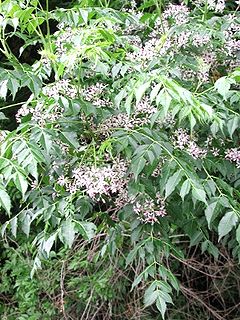
Meliaceae, the mahogany family, is a flowering plant family of mostly trees and shrubs in the order Sapindales.

Pandanales, the pandans or screw-pines, is an order of flowering plants placed in the monocot clade in the Angiosperm Phylogeny Group and Angiosperm Phylogeny Web systems. Within the monocots Pandanales are grouped in the lilioid monocots where they are in a sister group relationship with the Dioscoreales. Historically the order has consisted of a number of different families in different systems but modern classification of the order is based primarily on molecular phylogenetics despite diverse morphology which previously placed many of the families in other groupings based on apparent similarity. Members of the order have a subtropical distribution and includes trees, shrubs, and vines as well as herbaceous plants. The order consists of 5 families, 36 genera and about 1,610 species.

The Atherospermataceae, commonly known as the southern sassafrases, are a family of broadleaf evergreen trees and shrubs. The family includes 14 species in seven genera. The atherosperms are today mostly distributed in the Southern Hemisphere, with two species native to southern Chile and 12 species native to Australasia. Wood is commercially harvested from rainforest species of this family, and is used both in construction and in fine cabinet making.
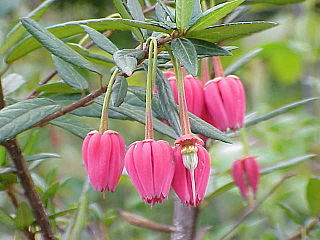
Elaeaocarpaceae is a family of flowering plants. The family contains approximately 615 species of trees and shrubs in 12 genera. The largest genera are Elaeocarpus, with about 350 species, and Sloanea, with about 120.

Abrophyllum is a monotypic genus of flowering plants in the family Saxifragaceae sensu lato according to Engler, A. in Engler & Prantl and Schulze-Menz, G. K. in Melchior, 1964; placed in Subfamily Escallonioideae, Tribe Cuttsieae, it is closely related to Cuttsia. In the APG II system Abrophyllum is placed in family Rousseaceae.

Hicksbeachia is a genus of two species of trees in the family Proteaceae. They are native to rainforests of northern New South Wales and southeastern Queensland. They are commonly known as red bopple nut or beef nut due to the bright red colour of their fruits.
Triunia is a genus of medium to tall shrubs or small trees found as understorey plants in rainforests of eastern Australia. Members of the plant family Proteaceae, they are notable for their poisonous fleshy fruits or drupes. Only one species, T. youngiana, is commonly seen in cultivation.

Alloxylon flammeum, commonly known as the Queensland tree waratah or red silky oak, is a medium-sized tree of the family Proteaceae found in the Queensland tropical rain forests of northeastern Australia. It has shiny green elliptical leaves up to 18 cm (7.1 in) long, and prominent orange-red inflorescences that appear from August to October, followed by rectangular woody seed pods that ripen in February and March. Juvenile plants have large deeply lobed pinnate leaves. Previously known as Oreocallis wickhamii, the initial specimen turned out to be a different species to the one cultivated and hence a new scientific name was required. Described formally by Peter Weston and Mike Crisp in 1991, A. flammeum was designated the type species of the genus Alloxylon. This genus contains the four species previously classified in Oreocallis that are found in Australasia.
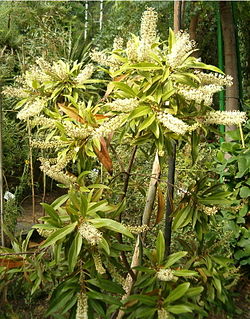
Buckinghamia is a genus of only two known species of trees, belonging to the plant family Proteaceae. They are endemic to the rainforests of the wet tropics region of north eastern Queensland, Australia. The ivory curl flower, B. celsissima, is the well known, popular and widely cultivated species in gardens and parks, in eastern and southern mainland Australia, and additionally as street trees north from about Brisbane. The second species, B. ferruginiflora, was only recently described in 1988.
Cardwellia is a genus of a sole described species of large trees in the plant family Proteaceae. The species Cardwellia sublimis is endemic to the rainforests of the wet tropics region of northeastern Queensland, Australia. Other common names include bull oak, golden spanglewood, lacewood, oak and oongaary. The compound leaves have up to 17 leaflets. It produces white inflorescences followed by woody fruits which are prominently displayed outside the canopy.

Cuttsia viburnea is a shrub or bushy tree which has toothed leaves and panicles of white flowers, and that is endemic to eastern Australia. It is sometimes called silver-leaved cuttsia, and confusingly also native elderberry, honey bush or native hydrangea. C. viburnea is the only species assigned to the genus Cuttsia.
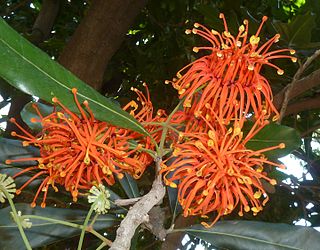
Stenocarpus sinuatus, known as the firewheel tree, is an Australian rainforest tree in the family Proteaceae. The range of natural distribution is in various rainforest types from the Nambucca River in New South Wales to the Atherton Tableland in tropical Queensland. Stenocarpus sinuatus is widely planted as an ornamental tree in other parts of Australia and in different parts of the world.
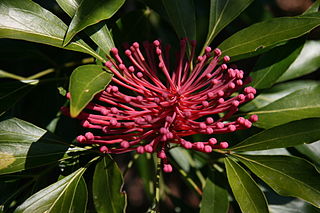
Alloxylon pinnatum, known as Dorrigo waratah, is a tree of the family Proteaceae found in warm-temperate rainforest of south-east Queensland and northern New South Wales in eastern Australia. It has shiny green leaves that are either pinnate (lobed) and up to 30 cm (12 in) long, or lanceolate (spear-shaped) and up to 15 cm (5.9 in) long. The prominent pinkish-red flower heads, known as inflorescences, appear in spring and summer; these are made up of 50 to 140 individual flowers arranged in corymb or raceme. These are followed by rectangular woody seed pods, which bear two rows of winged seeds.

Agastachys odorata, commonly known as the white waratah, is the sole member of the genus Agastachys in the protea family. It is an evergreen shrub to small tree and is endemic to the heaths and button grass sedgelands of western Tasmania. It occurs most often in moist heath and scrub and occasionally in the alpine regions, but generally prefers well-drained but poor soils. It can grow in some rainforests where it forms a small tree but is normally a shrub in all other situations. The heaviest concentrations are along the island's south coast. Its leaves are dark green, hairless and almost succulent. Masses of white flowers are produced in erect spikes from the ends of the branches. Measuring 8 to 12 cm high, they appear in January and February.

Cenarrhenes is a monytypic genus in the family Proteaceae containing the single species Cenarrhenes nitida, known as the Port Arthur plum or native plum. Cenarrhenes nitida is an evergreen shrub to small tree endemic to the rainforests and scrublands of western Tasmania. It bears white flowers in late spring followed by the development of fleshy fruit.
Hollandaea is a small genus of plants in the family Proteaceae containing four species of Australian rainforest trees. All four species are endemic to restricted areas of the Wet Tropics of northeast Queensland.

Placospermum is a genus of a single species of large trees, constituting part of the plant family Proteaceae. The species Placospermum coriaceum is endemic to the rainforests of the wet tropics region of northeastern Queensland, Australia. Common names include rose silky oak and plate-seeded oak.

The Solanaceae, or nightshades, are a family of flowering plants that ranges from annual and perennial herbs to vines, lianas, epiphytes, shrubs, and trees, and includes a number of agricultural crops, medicinal plants, spices, weeds, and ornamentals. Many members of the family contain potent alkaloids, and some are highly toxic, but many—including tomatoes, potatoes, eggplant, bell and chili peppers—are used as food. The family belongs to the order Solanales, in the asterid group and class Magnoliopsida (dicotyledons). The Solanaceae consists of about 98 genera and some 2,700 species, with a great diversity of habitats, morphology and ecology.

Ackama paniculosa, synonym Caldcluvia paniculosa, known as the soft corkwood, is a rainforest tree of eastern Australia. It occurs from Ourimbah, Central Coast at 33° S to Eungella National Park in tropical Queensland. Other common names include corkwood, rose-leaf marara, brown alder and sugarbark.
![<i>Brexia</i> Brexia is a shrub or tree genus assigned to the family [[Celastraceae]] from the East coast of tropical East Africa and Madagascar](https://upload.wikimedia.org/wikipedia/commons/thumb/e/e5/Brexia_madagascariensis_BotGardBln1105FlowerC.JPG/320px-Brexia_madagascariensis_BotGardBln1105FlowerC.JPG)
Brexia is a plant genus assigned to the Celastraceae. It is a dense evergreen shrub or small tree of usually around 5 m high, with alternately set, simple, leathery leaves with a short leaf stem and lanceolate to inverted egg-shaped leaf blades. The pentamerous flowers occur in cymes. The petals are greenish white, the samens are alternating with wide, incised staminodes. The superior ovary develops in a long ribbed fruit. Brexia naturally grows on the coast of East Africa, on Madagascar, the Comoros and Seychelles. Opinions differ about the number of species in Brexia. Sometimes the genus is regarded monotypic, B. madagascariensis being a species with a large variability, but other authors distinguish as many as twelve species. Common names for B. madagascariensis include jobiapototra, tsimiranjana, tsivavena, vahilava, voalava, voankatanana, voantalanina, voatalanina and votalanina, and mfukufuku (Swahili), mfurugudu and bwa kato (Seychelles).

















![<i>Brexia</i> Brexia is a shrub or tree genus assigned to the family [[Celastraceae]] from the East coast of tropical East Africa and Madagascar](https://upload.wikimedia.org/wikipedia/commons/thumb/e/e5/Brexia_madagascariensis_BotGardBln1105FlowerC.JPG/320px-Brexia_madagascariensis_BotGardBln1105FlowerC.JPG)